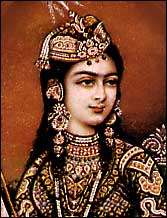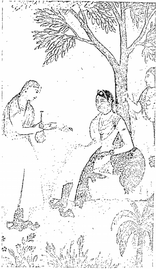Jagat Gosain
Jagat Gosain (Persian: جگت گوسین, lit. 'Mistress of the World';[1] 13 May 1573 –19 April 1619) was Empress consort of the Mughal Empire as the wife of Mughal emperor Jahangir and the mother of his successor, the fifth Mughal emperor Shah Jahan.[2][3] She is also known as Jodh Bai (Princess of Jodhpur)[4][5] and was given the posthumous title of Bilqis Makani.[6][7] She should not be confused with Mariam-uz-Zamani, who was also wrongly named "Jodha Bai" by European historians.[8]
| Jagat Gosain | |
|---|---|
 | |
| Empress consort of the Mughal Empire | |
| Reign | 3 November 1605 – 19 April 1619 |
| Born | Manavati Baiji Lall Sahiba 13 May 1573 Jodhpur, Rajasthan |
| Died | 19 April 1619 (aged 45) Agra, Mughal Empire |
| Burial | Suhagpura, Agra |
| Spouse | Jahangir |
| Issue | Begum Sultan Shah Jahan Izzat-un-nissa |
| Dynasty | House of Rathore (by birth) House of Timur (by marriage) |
| Father | Raja Udai Singh |
| Mother | Rani Manrang Devi |
| Religion | Hinduism |
By birth, she was a Rajput princess of Marwar (present-day Jodhpur) and was the daughter of Raja Udai Singh (popularly known as Mota Raja), the Rathore ruler of Marwar and the sister of Sawai Raja Sur Singh, another Rathore ruler of Marwar.[9][10]
Family
Known most popularly as Jodh Bai,[11] the Jodhpur princess[12] Jagat Gosain belonged to the Rathore clan of Rajputs and was a daughter of Raja Udai Singh,[5] the ruler of Marwar (present-day Jodhpur).[13] Udai Singh was popularly known by the sobriquet Mota Raja (the fat king).[14] Her mother was Manrang Devi,[15] daughter of Raja Askaran of Narwar (d.1599),[16] who was also briefly Raja of Amber before being ousted in favour of his uncle, Bharmal.[17]
Her paternal grandfather was Maldeo Rathore,[18] under whose rule Marwar turned into a strong Rajput Kingdom that resisted foreign rule and challenged the invaders for northern supremacy. Maldeo Rathore refused to ally with either the Sur Empire or the Mughal Empire after Humayun regained control of North India in 1555. This policy was continued by his son and successor Chandrasen Rathore.[19]
After the death of Maldeo Rathore in 1562, a fratricidal war for succession started and Chandrasen crowned himself in the capital Jodhpur. But his reign was short lived as Emperor Akbar's army occupied Merta in the same year and the capital Jodhpur in 1563.[20]
After the death of Rao Chandrasen in January 1581, Marwar was brought under direct Mughal administration. In August 1583, Akbar restored the throne of Marwar to Udai Singh, who, unlike his predecessors, submitted to the Mughals and subsequently joined the Mughal service.[20]
Marriage to Jahangir

After submitting to the Mughals, Udai Singh decided to give his daughter Jagat Gosain in marriage to Akbar's eldest son, Prince Salim. According to historian Norman P. Ziegler, some Rajput nobles did not like the idea of their kings marrying their daughters to the Mughal emperor, as they considered it a sign of humiliation and degradation. The discontent amongst the nobles gave rise to a rebellion led by Kalyandas Rathore. The rebellion was soon put to an end by Raja Udai Singh after a siege of the Siwana fort and the death of Kalyandas Rathore.[21]
Jagat Gosain married the 16 year-old Prince Salim (later known as 'Jahangir' upon his accession) on 26 June 1586. Although the marriage was a political one, Jagat was known not only for her beauty and charm but for her wit, courage, and spontaneity of response - all of which greatly endeared her to her husband during the early years of their marriage.[22] In 1590, she gave birth to her first child, a daughter, named Begum Sultan, who died at the age of one.[23] On 5 January 1592, she gave birth to Salim's third son, who was named 'Khurram' ("joyous") by his grandfather, the Emperor Akbar. The prince, who was to become the future emperor Shah Jahan, was Akbar's favourite grandson and in the words of Jahangir "was more attentive to my father [Akbar] than all [my] children... He recognized him as his own child."[11] After the birth of Shah Jahan, she was given the title Taj Bibi, meaning 'crown wife'.
Just prior to Khurram's birth, a soothsayer had reportedly predicted to the childless Empress Ruqaiya Sultan Begum (Akbar's chief wife)[24][25] that the still unborn child was destined for imperial greatness.[26] So, when Khurram was only six days old, Akbar ordered that the prince be taken away from Jagat Gosaini and handed him over to Ruqaiya so that he could grow up under her care and Akbar could fulfill his wife's wish, to raise a Mughal emperor.[26] Jagat was consoled with a magnificent gift of rubies and pearls.[27]
Ruqaiya assumed the primary responsibility for Khurram's upbringing and he grew up under her care.[28] The two shared a close relationship with each other as Jahangir noted in his memoirs, that Ruqaiya had loved his son, Khurram, "a thousand times more than if he had been her own [son]."[29] Khurram remained with her until he had turned almost 14. After Akbar's death in 1605, the young prince was allowed to return to his father's household, and thus, became closer to his biological mother.[26] In the intervening years, Jagat had given birth to her third (and last) child in 1597, a daughter, Izzat-un-nissa, who died in infancy.[23]
Jagat Gosain seems to have lost her husband's favour quite early on in their marriage,[30] more so after the arrival of her arch-rival in the imperial harem, Nur Jahaṇ, of whom Jagat was scornful. Jahangir had married her in 1611 and from the time of their marriage until his death, Nur Jahan was indisputably his most favourite wife.[31] Even prior to his marriage with Nur Jahan, Jahangir's chief consort and Padshah Begum was his wife, Saliha Banu Begum, who held this position from the time of his accession in 1605 till her death in 1620, after which these honorable titles were passed on to Nur Jahan.[11]
Death
Jagat Gosain died on 19 April 1619 at Agra.[32] Jahangir noted the death briefly, saying simply that she had "attained the mercy of God." After her death, Jahangir ordered that she be called Bilqis Makani ("the Lady of Pure Abode")[33] in all of the official documents.[34]
She was buried in Suhagpura, Agra.[35] Her tomb consisted of a high dome, gateways, towers and a garden situated in the cantonment area. All of this was blown up in 1832 with gunpowder, for the sake of its site and material, stone and brick, which the British needed.[36]
In popular culture
- Jagat Gosain is a principal character in Indu Sundaresan's award-winning historical novel The Twentieth Wife (2002)[37] as well as in its sequel The Feast of Roses (2003).[38]
- Nayani Dixit portrayed Jagat Gosain in EPIC channel's critically acclaimed historical drama Siyaasat (based on the Twentieth Wife).
Ancestry
References
- Shyamaldas, Kaviraj (1888). Translated by Prasad, Babu Ram. "The Mother of Jahangir". Journal of the Asiatic Society of Bengal. Asiatic Society (Kolkata, India). 57 (1.2): 71.
- Manuel, edited by Paul Christopher; Lyon, Alynna; Wilcox, Clyde (2012). Religion and Politics in a Global Society Comparative Perspectives from the Portuguese-Speaking World. Lanham: Lexington Books. p. 68. ISBN 9780739176818.CS1 maint: extra text: authors list (link)
- Eraly, Abraham (2007). Emperors of the Peacock Throne, The Saga of the Great Mughals. Penguin Books India. p. 299. ISBN 978-0141001432.
- Findly, p. 396
- transl.; ed.; Thackston, annot. by Wheeler M. (1999). The Jahangirnama : memoirs of Jahangir, Emperor of India. New York [u.a.]: Oxford Univ. Press. p. 13. ISBN 9780195127188.CS1 maint: extra text: authors list (link)
- Sharma, Sudha (2016). The Status of Muslim Women in Medieval India. SAGE Publications India. p. 144. ISBN 9789351505679.
- Lal, K.S. (1988). The Mughal harem. New Delhi: Aditya Prakashan. p. 149. ISBN 9788185179032.
- Jhala, Angma Dey (2011). Royal Patronage, Power and Aesthetics in Princely India. Pickering & Chatto Limited. p. 119.
- Shujauddin, Mohammad; Shujauddin, Razia (1967). The Life and Times of Noor Jahan. Lahore: Caravan Book House. p. 50.
- Balabanlilar, Lisa (2015). Imperial Identity in the Mughal Empire: Memory and Dynastic Politics in Early Modern South and Central Asia. I.B.Tauris. p. 10. ISBN 9780857732460.
- Findly, p. 125
- Tillotson, Giles (2008). Taj Mahal. Cambridge, Mass.: Harvard University Press. p. 28. ISBN 9780674063655.
- Chandra, Satish (2005). Medieval India : from Sultanat to the Mughals (Revised ed.). New Delhi: Har-Anand Publications. p. 116. ISBN 9788124110669.
- Mehta, Jaswant Lal (1986). Advanced Study in the History of Medieval India. Sterling Publishers Pvt. Ltd. p. 418. ISBN 9788120710153.
- Soma Mukherjee, Royal Mughal Ladies and Their Contributions (2001), p. 128
- Richard Saran and Norman P. Ziegler, The Mertiyo Rathors of Merto, Rajasthan (2001), p. 45
- Sarkar, J. N. (1994) [1984]. A History of Jaipur (Reprinted ed.). Orient Longman. p. 33. ISBN 81-250-0333-9.CS1 maint: ref=harv (link)
- Lal, K.S. (1988). The Mughal harem. New Delhi: Aditya Prakashan. p. 27. ISBN 9788185179032.
- Bose, Melia Belli (2015). Royal Umbrellas of Stone: Memory, Politics, and Public Identity in Rajput Funerary Art. BRILL. p. 150. ISBN 978-9-00430-056-9.
- Sarkar 1994, p. 41
- Ziegler, Norman P. (1998). "Some Notes on Rājpūt Loyalties During the Mugẖal Period". In Alam, Muzaffar; Subrahmanyam, Sanjay (eds.). The Mughal State, 1526–1750. Oxford University Press. p. 198. ISBN 978-0-19-565225-3.
- Findly, p. 124
- Moosvi, Shireen (2008). People, taxation, and trade in Mughal India. Oxford: Oxford University Press. p. 114. ISBN 9780195693157.
- Burke, S. M. (1989). Akbar, the greatest Mogul. Munshiram Manoharlal Publishers. p. 142.
- Jahangir, Emperor of Hindustan (1999). The Jahangirnama: Memoirs of Jahangir, Emperor of India. Translated by Thackston, Wheeler M. Oxford University Press. p. 437. ISBN 978-0-19-512718-8.
Ruqayya-Sultan Begam, the daughter of Mirza Hindal and wife of His Majesty Arsh-Ashyani [Akbar], had passed away in Akbarabad. She was His Majesty's chief wife. Since she did not have children, when Shahjahan was born His Majesty Arsh-Ashyani entrusted that "unique pearl of the caliphate" to the begam's care, and she undertook to raise the prince. She departed this life at the age of eighty-four.
- Faruqui, Munis D. Princes of the Mughal Empire, 1504–1719. Cambridge University Press. p. 71. ISBN 978-1-107-02217-1.
- Diana; Preston, Michael (2008). A teardrop on the cheek of time : the story of the Taj Mahal. London: Corgi. ISBN 978-0552154154.
The Hindu Jodh Bai was consoled with a magnificent gift of rubies and pearls
- Eraly, Abraham (2000). Emperors of the Peacock Throne: The Saga of the Great Mughals. Penguin Books India. p. 299. ISBN 978-0-14-100143-2. Retrieved 22 November 2014.
- Jahangir (1968). Henry Beveridge (ed.). The Tūzuk-i-Jahāngīrī: or, Memoirs of Jāhāngīr, Volumes 1–2. Munshiram Manoharlal. p. 48.
- Findly, p. 49
- Findly, p. 126
- transl.; ed.; Thackston, annot. by Wheeler M. (1999). The Jahangirnama : memoirs of Jahangir, Emperor of India. New York [u.a.]: Oxford Univ. Press. p. 300. ISBN 9780195127188.CS1 maint: extra text: authors list (link)
- Findly, p. 94
- Findly, p. 162
- Srivastava, Ashirbadi Lal (1973). Society and culture in 16th century India. Shiva Lal Agarwala. p. 293.
- Nath, R. (1989). Histographical Study of Indo-Muslim Study: Medieval Architecture of India and Pakistan. Historical Research Documentation Programme. p. 10. ISBN 978-8-185-10510-9.
- Sundaresan, Indu (2002). Twentieth wife : a novel (Paperback ed.). New York: Washington Square Press. p. 11. ISBN 9780743428187.
- Sundaresan, Indu (2003). The Feast of Roses: A Novel. Simon and Schuster. ISBN 9780743481960.
- Shyam Singh Ratnawat, Krishna Gopal Sharma, History and culture of Rajasthan: from earliest times upto 1956 A.D. (1999), p.162
- Rajvi Amar Singh, Mediaeval History of Rajasthan: Western Rajasthan (1992), p.38
- Sarkar 1994, p. 28
Bibliography
- Findly, Ellison Banks (1993). Nur Jahan: Empress of Mughal India. Oxford University Press. ISBN 9780195360608.
External links
| Wikimedia Commons has media related to Jagat Gosaini. |